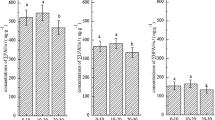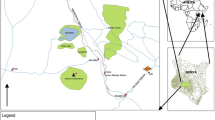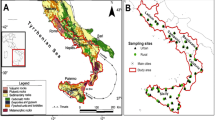Abstract
Continuous oil exploration and exploitation activities in the Niger Delta region have led to the area being plagued by oil pollution. Baseline and detailed studies have been reported in the southeastern part of the region; however, in the southwestern part, some authors have ascribed the pollution in the area with oil production activities, with no empirical evidence to justify the claim. This present work is a baseline study utilizing polycyclic aromatic hydrocarbons (PAHs) extracted from soils and sediments in four (4) localities within the southwestern part of the Niger Delta region, with the aim of determining the sources and level of pollution in the area. A total of fifteen (15) samples, made up of four (4) sediments and eleven (11) soil samples, were collected. Identification and quantification of PAHs were performed using a Shimadzu GC/MS QP 2010 model. In all soil samples analyzed, 15 PAHs were identified (naphthalene (Nap), acenaphthylene (Acy), acenaphthene (Ace), fluorene (Flu), phenanthrene (Phe), anthracene (Ant), pyrene (Pyr), benz(a)anthracene (BaA), chrysene (Chr), benzo(b)fluoranthene (BbFl), benzo(k)fluoranthene (BkFl), benzo(a)pyrene (BaP), dibenz[a,h]anthracene (DahA), benzo[g,h,i]perylene (BePe), and indeno[1,2,3-c,d]perylene (InP)) while 6 were detected in the sediments (Nap, Flu, Phe, Ant, BaP, DahA). The concentrations of PAHs identified in the soil and the sediment samples ranged from 0.056 to 52.640 ng/g (∑PAHs 57.998 ng/g) and from 0.188 to 0.932 ng/g (∑PAHs 2.052 ng/g), respectively. The ranges of different diagnostic ratios used indicated more of pyrogenic sources, with the exception of low molecular weight polycyclic aromatic hydrocarbons to high molecular weight polycyclic aromatic hydrocarbons ratio (LMWPAH/HMWPAH), which indicated a petrogenic source. Generally, the PAH concentration in the samples was relatively low and below standard thresholds of toxicity. However, the presence of some carcinogenic PAHs, though at lower concentrations, may pose threat to the ecosystem if not monitored.





Similar content being viewed by others
Data availability
Not applicable.
Code availability
Not applicable.
References
Abiodun OA, Omobola OO, Okoh AI, (2018) Analytical methods for polycyclic aromatic hydrocarbons and their global trend of distribution in water and sediment: a review 19: 394-428
Adedosu TA, Adedosu HO, Sojinu OS, Olajire AA (2013) N-alkanes and polycyclic aromatic hydrocarbons (PAHs) profile of soil from some polluted sites in Niger Delta, Nigeria. Environ Earth Sci 68:2138–2144
Babatunde A (2010) The impact of oil exploitation on the socio-economic life of the Ilaje-Ugbo people of Ondo State, Nigeria. J Sustain Dev Africa 12:19–29
Balogun SO, Kareem B (2013) The effects of oil spillage on aquatic environment in Ilaje environment, Nigeria. Int J Eng Innov Manag 3:19–29
Beyer WN (1990) Evaluating soil contamination. United States Fish and Wildlife Service, Biological Report
Coker SJL, Ejedawe JE (1987) Petroleum prospect of the Benin basin Nigeria. J Min Geol 23(1):7–43
Doust H, Omatsola E (1990) Niger Delta divergent/passive margin basins In: Edwards, J D and Santogrossi, P A, (Eds), American Association of Petroleum. Geologists Memoir 48:239–248
Elueze AA, Nton ME (2004) Organic geochemical appraisal of limestones and shales in part of eastern Dahomey basin, southwestern Nigeria. J Min Geol 40:29–40
Ite AE, Ibok UJ, Ite MU, Petters SW (2013) Petroleum exploration and production: past and present environmental issues in the Nigeria’s Niger delta. Ame J Environ Prot 1:78–90
Long ER, MacDonald DD, Smith SL, Calder FD (1995) Incidence of adverse biological effects within ranges of chemical concentration in marine and estuarine sediments. J Environ Manag 19:18–97
Long ER, Morgan LG (1991) The potential for biological effects of sediment-sorbed contaminants tested in the National status and trends program. NOAA Technical Memorandum NOS OMA 52, National Oceanic and Atmospheric Administration, Seattle, WA
MacDonald DD, Carr RS, Calder FD, Long ER, Ingersoil CG (1996) Development and evaluation of sediment quality guidelines for Florida coastal waters. Ecotoxicity 5(4):253–278
Magi E, Bianco R, Ianni C, Di Carro M (2002) Distribution of polycyclic aromatic hydrocarbons in the sediments of the Adriatic Sea. Environ Pollut 119(1):91–98
National Oceanic and Atmospheric Administration (1998) Summary of chemical contaminant levels at benthic surveillance project sites (1984–1992). US Department of Commerce, Maryland.
Okedoyin OE (2021) Geochemical fingerprinting and diagnostic ratios of oil impacted sites in Ilaje, Southwestern Nigeria. Dissertation, University of Ibadan
Omatsola ME, Adegoke OS (1981) Tectonic evolution and Cretaceous stratigraphy of the Dahomey basin. Nigeria J Min Geol 18(1):130–137
Onuoha KM (1999) Structural features of Nigeria’s Coastal margin: an assessment based on age data from wells. J Afr Earth Sc 29(3):485–499
Pies C, Hoffmann B, Petrowsky J, Yang Y, Ternes TA, Hofmann T (2008) Characterization and source identification of polycyclic aromatic hydrocarbons (PAHs) in river bank soils. Chemosphere Journal 72:1594–1601
Sarria-Villa R, Ocampo-Duqua W, Paez M, Schuhmacher M (2015) Presence of PAHs in water and sediments of the Colombian-Cauca River during heavy rain episodes and implications for risk assessment. Sci Total Environ 540:455–465
Smith SL, MacDonald DD, Keenleyside KA, Ingersoil CG, Field J (1996) A preliminary evaluation of sediment quality assessment values for freshwater ecosystems. J Great Lakes Res 22:624–638
Ugwuanyi CA, Garba A, Makarau SB (2012) The impacts of environmental pollution on agricultural productivity in the Niger Delta. Journal of Environ Sci Res Manag 4:26–33
USEPA (US Environmental Protection Agency) (1995) Soil screening for polynuclear aromatic hydrocarbons by immunoassay, test methods for evaluating solid waste, physical/chemical methods. US Environmental Protection Agency, Washington, D.C.
Vassiliou S (2009) The A to Z of the petroleum industry. Sacrecrow Press
Weber KJ, Daukoru EM (1975) Petroleum geology of the Niger Delta. Proceedings of the 9th World Petroleum Congress, Geology. London: Applied Science Publishers 2: 210–221
Whiteman AJ (1982) Nigeria: its petroleum geology resources and potentials. Graham and Trotman, London, U.K
Wilson RC, Williams CA (1979) Oceanic transform structures and the developments of Atlantic continental margin sedimentary basin a review. J Geol Soc London 136:311–320
Wu H, Sun B, Li J (2019) Polycyclic aromatic hydrocarbons in sediments/soils of the rapidly urbanized lower reaches of the River Chaohu, China. Int J Environ Res Public Health 16:2302
Acknowledgements
We wish to appreciate Mr. K. Egunjobi, Dr. A.O. Adeyi, and Mrs. Yekini for their contributions during field sampling and laboratory work. The authors are also grateful to the staff and students of the Department of Geology, University of Ibadan, Nigeria, for providing a good academic environment where this study was carried out.
Funding
This work was supported by the African Union through the Pan African University Life and Earth Sciences Institute, University of Ibadan.
Author information
Authors and Affiliations
Corresponding author
Ethics declarations
Ethics approval
Not applicable.
Consent to participate
Not applicable.
Consent for publication
Not applicable.
Conflict of interest
The authors declare that they have no competing interests.
Additional information
Responsible Editor: Santanu Banerjee
Rights and permissions
Springer Nature or its licensor holds exclusive rights to this article under a publishing agreement with the author(s) or other rightsholder(s); author self-archiving of the accepted manuscript version of this article is solely governed by the terms of such publishing agreement and applicable law.
About this article
Cite this article
Okedoyin, O., Nton, M.E. & Adeleye, M.A. Environmental impacts and distribution of polycyclic aromatic hydrocarbons (PAHs) in soils and sediments in Ilaje area, southwestern Nigeria. Arab J Geosci 15, 1404 (2022). https://doi.org/10.1007/s12517-022-10684-4
Received:
Accepted:
Published:
DOI: https://doi.org/10.1007/s12517-022-10684-4




